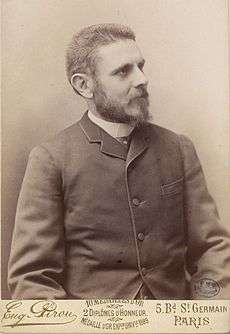Pierre Marie
Pierre Marie (9 September 1853 – 13 April 1940) was a French neurologist who was a native of Paris.
Pierre Marie | |
|---|---|
 Pierre Marie | |
| Born | 9 September 1853 Paris |
| Died | 13 April 1940 (aged 86) |
| Known for | acromegaly, Charcot–Marie–Tooth disease |
| Scientific career | |
| Fields | neurologist endocrinology |
| Institutions | Salpêtrière |
| Influences | Jean-Martin Charcot |
Life and career
After finishing medical school, he served as an interne (1878), working as an assistant to neurologist Jean-Martin Charcot (1825–1893) at the Salpêtrière and Bicêtre Hospitals in Paris. In 1883 he received his medical doctorate with a graduate thesis on Basedow’s disease, being promoted to médecin des hôpitaux several years later (1888). In 1907 he attained the chair of pathological anatomy at the Faculty of Medicine, and in 1917 was appointed to the chair of neurology, a position he held until 1925. In 1911 Marie became a member of the Académie de Médecine.
One of Marie's earlier contributions was a description of a disorder of the pituitary gland known as acromegaly. His analysis of the disease was an important contribution in the emerging field of endocrinology. Marie is also credited as the first to describe pulmonary hypertrophic osteoarthropathy, cleidocranial dysostosis and rhizomelic spondylosis. In his extensive research of aphasia, his views concerning language disorders sharply contrasted the generally accepted views of Paul Broca (1824–1880). In 1907, he was the first person to describe the speech production disorder of foreign accent syndrome.[1]
Marie was the first general secretary of the Société Française de Neurologie, and with Édouard Brissaud (1852–1909), he was co-founder of the journal Revue neurologique. His name is associated with the eponymous Charcot–Marie–Tooth disease, being named along with Jean-Martin Charcot and Howard Henry Tooth (1856–1925). This disease is characterized by gradual progressive loss of distal muscle tissue in the arms and feet. It is considered the most common disease within a group of conditions known as "hereditary motor and sensory neuropathies" (HMSN).[2]
Among the doctors trained by Pierre Marie at the beginning of the XXth century account the Spanish neuropathologists Nicolás Achúcarro and Gonzalo Rodríguez Lafora, two distinguished disciples of Santiago Ramón y Cajal and members of the Spanish Neurological School.
Associated eponyms
- "Marie's ataxia": an hereditary disease of the nervous system, with cerebellar ataxia.
- "Marie-Foix-Alajouanine syndrome": cerebellar ataxia of the cerebellum in the elderly; usually due to alcohol abuse. Named along with neurologists Théophile Alajouanine (1890–1980) and Charles Foix (1882–1927).
- "Marie's anarthria": inability to articulate words due to cerebral lesions.
- "Marie–Strümpel Disease": also known as ankylosing spondylitis; a severe arthritic spinal deformity. Named along with German neurologist Adolph Strümpell (1853–1925). The disease is sometimes referred to as "Bekhterev Disease"; named after Russian neurophysiologist Vladimir Bekhterev (1857–1927).
- "Marie-Léri syndrome": hand deformity caused by osteolysis of the articular surfaces of the fingers. Named with neurologist André Léri (1875–1930).
- "Bamberger-Marie disease": also known as hypertrophic pulmonary osteoarthropathy. Named with Austrian internist Eugen von Bamberger (1858–1921).
Selected writings
- Des formes frustes de la maladie de Basedow, doctoral thesis, Paris, 1883.
- Sur deux cas d’acromégalie, 1886.
- Sur une form particulière d'atrophie musculaire progressive; souvent familiale, débutant par les pieds et les jambes et atteignant tard les mains, With Jean Martin Charcot. 1886
- "Essays on Acromegaly", with bibliography and appendix of cases by other authors. London, 1891.
- Leçons sur les maladies de la moëlle épinière, Paris, 1892. English translation by M. Lubbock as "Lectures on Diseases of the Spinal Cord", London, 1895.
- Sur l'hérédo-ataxie cérébelleuse, Semaine médicale, Paris, 1893, 13: 444.
- L’évolution du langage considéré au point de vue de l’étude de l’Aphasie, 1897.
- Dysostose cléido-crânienne héréditaire, with Paul Sainton (1868–1958); 1897.
- Spondylose rhizomélique, 1898.
- Neurologie, two volumes; 1923.
See also
Notes
- Marie P. (1907). Presentation de malades atteints d’anarthrie par lesion de l’hemisphere gauche du cerveau. Bulletins et Memoires Societe Medicale des Hopitaux de Paris, 1: 158–160.
- Charcot-Marie-Tooth disease Archived 2011-05-14 at the Wayback Machine @ Who Named It
References
- Pierre Marie @ Who Named It (biography)
- David G. Andrewes (2001). Neuropsychology. Psychology Press. ISBN 1-84169-103-8.